If I try to insert a new row into the table, I get an error: "New row violates row-level security policy for table".
I have a table "user_profiles" that have a foreign key "user_id" to auth table "auth.users.id"
I am using "supabase.auth.onAuthStateChange" hook where I want to add new row when user logs in.
In policies section, I have RLS enabled, but I didn't add any policies.
Then, I tried to add a policy from template that only authenticated users can add a row, but it didn't change anything.
Then, I came across this SO question and and tried to add a policy from template that only authenticated users can select, but I am still getting the same error.
I implemented authentication in chrome browser extension in background script:
supabase.ts
import { createClient } from '@supabase/supabase-js'
import qs from 'qs'
const supaUrl = import.meta.env.VITE_SUPABASE_URL
const supaANONKey = import.meta.env.VITE_SUPABASE_ANON_KEY
export const supabase = createClient(supaUrl, supaANONKey, {
global: {
fetch: (...args) => fetch(...args),
},
})
export const extensionSupabaseLogin = async () => {
const redirectUri = chrome.identity.getRedirectURL('supabase-auth')
const options = {
provider: 'notion',
redirect_to: redirectUri,
ux_mode: 'redirect',
}
const url = `${supaUrl}/auth/v1/authorize?${qs.stringify(options)}`
const originalTab = (await chrome.tabs.query({ active: true, currentWindow: true }))[0]
const authenticationTab = await chrome.tabs.create({ url: 'about:blank' })
chrome.tabs.onUpdated.addListener(function notionAuthHook(tabId, _changeInfo, tab) {
if (tabId === authenticationTab.id && tab.url?.startsWith(redirectUri)) {
const splitUrl = tab.url?.split('#')[1]
// Prompt user to sign in again if unparsable (error)
if (!splitUrl) {
console.error('Unparsable sign-in URL', tab.url)
return
}
// Parse tokens from URL
const authResult = qs.parse(splitUrl)
const refreshToken = authResult.refresh_token as string
const accessToken = authResult.access_token as string
// Prompt user to sign in again if no access_token (error)
if (!refreshToken || !accessToken) {
console.error('No access token or refresh token returned', authResult)
return
}
;(async () => {
const { error } = await supabase.auth.setSession({
access_token: accessToken,
refresh_token: refreshToken,
})
if (error) console.error(error)
})()
chrome.tabs.onUpdated.removeListener(notionAuthHook)
chrome.tabs.remove(tabId)
if (originalTab?.id) {
chrome.tabs.update(originalTab.id, { active: true })
}
}
})
// Send users to the sign-in flow
if (authenticationTab.id) {
await chrome.tabs.update(authenticationTab.id, { url: url })
}
}
background.ts
import { Client } from '@notionhq/client'
import { extensionSupabaseLogin, supabase } from './supabase'
chrome.runtime.onMessage.addListener((request, sender, sendResponse) => {
if (request.action === 'signIn') {
extensionSupabaseLogin();
} else if (request.type === 'GET_NOTION_PAGE') {
const { accessToken, ...options } = request.options as GetPageNotionOptions
debugger
if (!notionClient) {
setNotionClient(accessToken)
}
if (notionClient) {
const response = await notionClient.pages.retrieve({ ...options })
sendResponse({ type: 'SUCCESS', data: JSON.stringify(response) })
}
}
});
let notionClient: Client | null = null
const setNotionClient = (notionCode: string) => {
notionClient = new Client({
auth: notionCode,
})
}
const storeNotionIdentity = async (notionIdentity: { accessToken: string; refreshToken?: string }): Promise<void> => {
setNotionClient(notionIdentity.accessToken)
await chrome.storage.local.set({
notionIdentity,
})
}
const storeNotionUser = async (user: User): Promise<void> => {
await chrome.storage.local.set({
user,
})
}
const setupAuthListener = () => {
supabase.auth.onAuthStateChange(async (event, session) => {
if (event === 'SIGNED_IN' || event === 'USER_UPDATED') {
//this user has just signed in or their session has been updated
console.log('user is signed in :', session)
if (session?.access_token && session?.refresh_token) {
debugger
await storeNotionIdentity({ accessToken: session.access_token, refreshToken: session.refresh_token })
}
if (session?.user) {
await storeNotionUser({
name: session.user.user_metadata?.name,
fullName: session.user.user_metadata?.full_name,
email: session.user?.email ?? session.user.user_metadata?.email,
userId: session.user.id,
})
}
if (typeof loginTabId === 'number') {
chrome.tabs.sendMessage(loginTabId, `notion login success`)
}
} else if (event === 'SIGNED_OUT') {
//the user has just signed out or their account has been deleetd
console.log('user is signed out')
loginTabId = null
await chrome.storage.local.remove(['notionIdentity', 'user'])
}
})
}
setupAuthListener()





